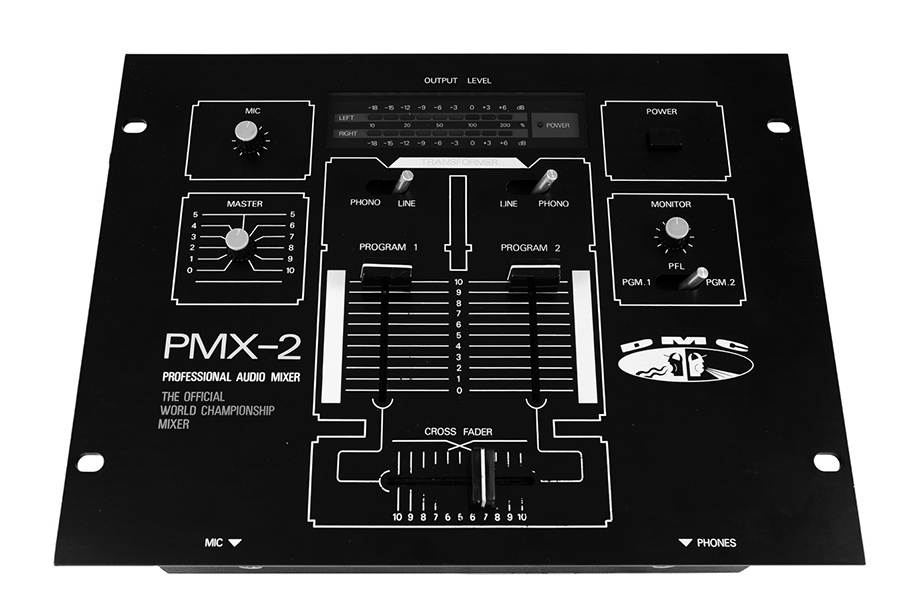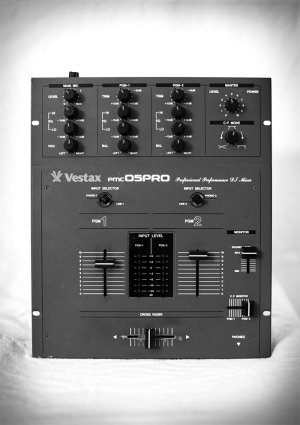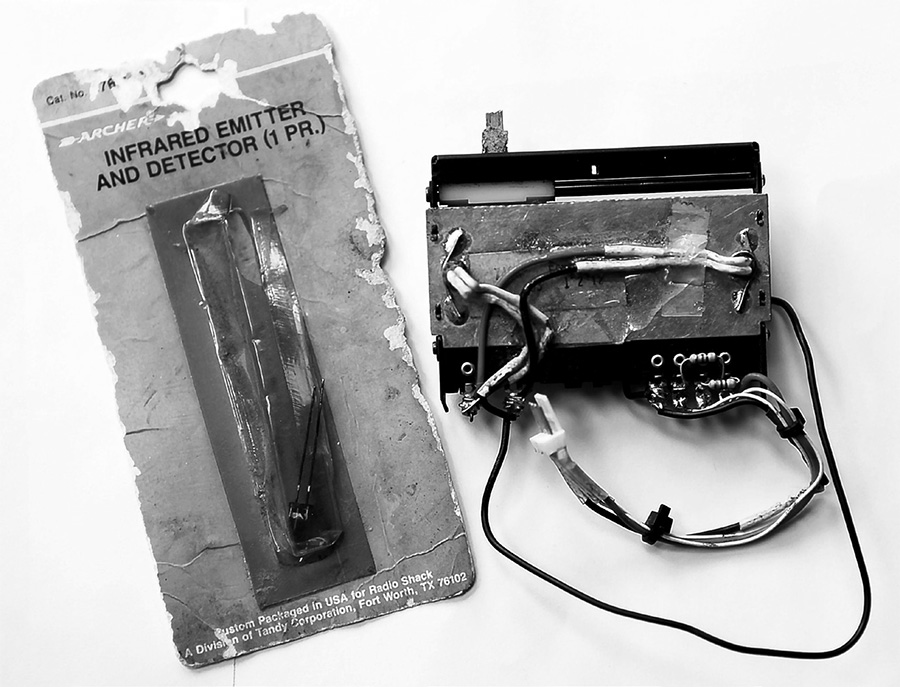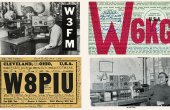Scratch Cyborgs: The Hip-Hop DJ as Technology

In 2009, I began research for my dissertation and eventual book, in which I chronicle the role of hip-hop DJs in the evolution of products that catered to their culture. I spoke with some of the key players in the DJ product industry and in DJ culture itself, and asked them something simple: “What do you think is the most important technical innovation in the history of DJing?” As you might imagine, most suggested products like the Technics 1200, digital vinyl systems, and sharp, contactless crossfaders like the one invented by DJ Focus in the late 90s.

Their answers make perfect sense; these products disrupted the industry and advanced the culture by allowing DJs’ ideas to come to life in new ways. But these answers only tell a part of the story. Consider, for example, the answer that Bay Area scratch legend DJ Quest gave to my question: “The thing that has advanced the most,” he said, “has been the hand.”
Quest’s answer is central here and to technocultural synergism as I present it. A common misconception is that technical innovation leads to innovations in technique. With respect to hip-hop DJing, I have found that it’s the other way around: Technical innovation follows innovations in DJ technique, or as Quest puts it, “the hand.” Whether finding new ways to use existing machines, or designing, inventing, and engineering their own equipment, DJs have participated in an ongoing feedback loop that shapes new technologies. Technical innovation is in a sense a product of the culture, not something external to it. Seen this way, hip-hop DJ culture provides a rich site for exploring innovation as a cycle, a dialectic, and a network.
A common misconception is that technical innovation leads to innovations in technique.
Technique and technical innovation are grounded in memory as well. For technique, it’s muscle memory and sonic memory, and applying these memories via practice. For technical innovation, these memories codified through DJ technique are encoded in products, and through use, these mixers are given meaning and develop a unique cultural and historical importance.
In what follows, I present a number of case studies that illustrate the synergy between hip-hop performance techniques and product development, specifically that of DJ mixers. While most writing about technological advancements considers the ways that technical innovations affect people, I want to flip the script and show how the development of new DJ mixers were influenced by DJ techniques themselves.
While house, club, and DJs from other electronic genres have had a huge impact on DJ culture and the DJ product industry, it is the hip-hop/scratch/turntablist DJs that have advanced the practice far beyond mixing and beat-matching techniques foregrounded in other genres. By reviewing some landmark moments in innovation from 1970 to 2000, we’ll see how hip-hop DJ culture has had the most visible impact on the DJ product industry and the ways in which mixers have been engineered and designed.
The 1970s: Pioneering Technique
Most of the literature out there suggests that hip-hop culture began as a reaction to disco, with impoverished Black teenagers rejecting the adult, mostly white, mostly middle-class culture of mid-to-late 1970s Manhattan clubs. While that is true in many ways, before disco was a genre it was a diverse subculture in New York City, that, like hip-hop, was commodified and sanitized by the music industry.
The documentary “Founding Fathers,” which focuses on the early Brooklyn mobile disco scene, showcases some of the ways that disco influenced hip-hop culture. For me, what stands out is the centrality of the DJ to both hip-hop and disco. Furthermore, some of the basic techniques pioneered by disco DJs, such as slip-cueing using slipmats and beatmatching, predated and thus influenced hip-hop DJ culture (even if indirectly). Therefore, disco is fundamental to understanding how DJ techniques were first encoded into DJ products.
The DJ most commonly cited as a pioneer of mixing two records together was Francis Grasso, who worked at downtown disco clubs, such as The Sanctuary and The Haven. In the late 1960s, Grasso was using a Rek-O-Kut mixer, a product designed for mixing audio for radio and television broadcasts, to seamlessly blend two songs together. As his popularity grew, so did his need for a mixer that could accommodate his style of mixing. Most broadcast mixers used both upfaders and rotary knobs to mix signals, but it was rare for them to have a headphone cue. The headphone cue turned out to be a major technical innovation that followed from DJ technique.
Before disco was a genre it was a diverse subculture in New York City, that, like hip-hop, was commodified and sanitized by the music industry.
In the early days of NYC’s disco subculture, there were no mobile DJ products, which meant that the earliest mixers were designed as installation pieces for specific nightclub venues. In 1971, Alex Rosner designed a simple stereo mixer named “Rosie” (after its red-colored faceplate) for Grasso to use at the Haven club. The prototype was simple: two phono inputs, a tape input, a mic input, and a headphone cue system. It was designed with Grasso’s style of mixing in mind and a reflection of his art and technique. Rosie enabled Grasso to cue mix on headphones, previewing his blends of different recordings before playing them over the club’s speakers.
Rosie was also the by-product of collaboration and modification; Rosner was able to use a mono mixer made by Louis Bozak for radio broadcasting and adapt it for Grasso’s style of club mixing, and of course Grasso gave feedback on what he needed. This collaboration would be vital to the history of DJ mixers, as it was Rosner along with another iconic sound engineer, Richard Long, who convinced Bozak that there was a market for a club DJ mixer, and in 1971 the Bozak CMA-10-2DL was released and installed in clubs around New York.
While the CMA-10-2DL was the first mass-produced mixer, it was really only accessible to established DJs playing in disco clubs. That limitation meant that the mobile DJs of Brooklyn and hip-hop DJs in the South Bronx would need to develop alternative solutions and techniques, techniques that would have a major impact on future products.
“Founding Fathers” specifically looks at how some of these DJs modified products on the market to suit their mixing needs. In the film, DJ Vernon recalls the technical ingenuity of Ricky Grant. Vernon explains how Grant took a Sony MX-14 mixer made for microphone mixing in live sound applications and “y-jacked” the channels, allowing him to mix with independent control of the volume levels coming from the turntables (now a standard “gain” or “trim” feature on modern DJ mixers). Vernon continues: “And from that, slick ass engineers at GLi saw the idea, copied it, and came out with the first 3800. They stole ideas from Ricky Grant.” This story of DJ innovations being copied and encoded into commercial DJ products is common in the history and development of DJ mixers.
The 3800, which came out in 1974-1975, around the same time that GLi, Inc. was founded in Brooklyn, was one of the first commercially available mobile DJ mixers and one of the first mixers that Kool Herc supposedly used. Despite what anybody has said, this is likely the first DJ mixer with a horizontal crossfader, an integral component in the history of hip-hop DJ technique because it’s the most natural tool for heavy-duty sound manipulation using the hand. Almost all companies designing and manufacturing mixers in this era were from NYC or elsewhere in the tri-state area because of the proximity to DJ culture. But, the parks and rec centers were also the first research and development labs for these companies. With so much technical and technique innovation happening in the parks, engineers at these companies saw what DJs were doing and the potential market for these types of products, and the GLi 3800 was likely the by-product of “borrowed” park jam innovation.
There are many accounts of the early hip-hop culture — DJ Kool Herc bringing out the breakbeats with his “Merry-Go-Round,” Grandmaster Flash developing his “Quick Mix Theory,” and Grand Wizzard Theodore serendipitously stumbling across scratching, for example. So, while BK’s mobile disco scene was popping, teenage DJs in the South Bronx had developed their own style of mixing, largely centered on isolating, repeating, and manipulating the drum break sections of their records.

Massively important here was that these DJs were making groundbreaking innovations in technique, developing new dexterous skills with the hand, as early as 1973. With the only DJ mixers available being club installs, young, poor, Black kids from the South Bronx, just like Ricky Grant, had to make technical modifications to products to allow for their style of mixing to advance. In the early days of hip-hop culture, DJs would modify and use microphone mixers. They would also find ingenious ways of using multiple stereo receivers to cut between breakbeats. One notable innovation was to use a stereo receiver and plug one turntable into the left channel and the other turntable into the right channel and then use the stereo pan control to cut between records. Plain and simple, these hip-hop DJs in the South Bronx lacked access to the few DJ mixers that were on the market.
Throughout most the 1970s, DJ mixers were aimed at the mobile disco DJ market and designed to perform long transitions between songs. By the late 1970s, mixers like the GLi 3800, CM Labs CM-607 and Meteor Light & Sound’s Clubman line (the One-One, Two, and Two-Two, for example) grew in popularity and use amongst hip-hop DJs. Again, these products were not designed for their style of mixing, cutting, and scratching, as most of these mixers were large (often 19″ in width), and relied on rotary knobs or upfaders to control signals; but hip-hop DJs made do and continued to adopt and adapt into the 1980s. Manufacturers were paying attention to what DJs were doing in NYC, but largely ignoring the style and innovations coming out of the city’s poorest borough. However, they could only ignore this innovative style for so long.
1980s: Legendary Style
While the 1970s gave birth to the foundational practices of DJing and the products to try and accommodate club DJs, the 1980s was a decade of serious technical innovation. As the breakbeat style of DJing spread outside of NYC, notably to Philly, DJs began to push the possibilities of the human hand while technological innovations followed. These DJs took from the pioneering hip-hop DJs — specifically, scratching and cutting breakbeats on time — and brought that to the next level. Scratching became faster and more precise, while cutting two copies of the record went from just being on time to funky rearrangements of songs (also known as beat juggling). The human hand was developing at a speed much faster than DJ mixers.
The mixer that defined much of the early 1980s style and served as a great segue from the decade before was the GLi PMX 9000. Despite being a 19″ wide mixer geared towards club use, the PMX 9000 had a horizontal crossfader, a semi-rarity when this came out in 1979/1980, and thus became a favorite mixer of DJs like Jam Master Jay, UTFO’s Mixmaster Ice, Whodini’s Grandmaster Dee, and DJ Cheese. In fact, DJ Cheese used this mixer when he won the DMC World DJ Championships in 1986, effectively introducing scratching to the annual competition. Because of the size of the mixer, Cheese (and others) would set up their turntables on one side of the mixer in order to be a bit faster with both hands, a style known as “Axe Style.” While more mixers of the time used rotary dials, the 9000 was all faders. Despite its popularity amongst hip-hop DJs, it did not reflect their style of DJing. Thus, the true innovation was in the hand and how this mixer was used.
The human hand was developing at a speed much faster than DJ mixers.
Seeing a need for DJ mixers that were more compact, essentially more “mobile,” two iconic brands emerged to prominence in the 1980s: Numark and Gemini. The brands’ popularity was relegated to hip-hop DJs on each coast in the U.S., although both were based in New York, with Gemini taking over in Philly and NYC and the Numark rising to fame amongst DJs in Los Angeles and in the Bay area. At the time rap music and hip-hop in general was still considered to be a youth fad that would fall from popularity, and thus none of the DJ mixers reflected the style and needs of the hip-hop DJ.
If you were coming up in Philly, then the Gemini MX-1100 was the mixer of choice during the early-to-mid 80s. It was the mixer that DJs like Cash Money, Jazzy Jeff, Tat Money and others in the area likely developed two fundamental techniques on: the transform and chirp. Before he helped make the Gemini MX-2200 an iconic mixer, the 1100 was DJ Cash Money’s mixer of choice. It was small and had a clean and simple layout and a horizontal crossfader. It marked the movement away from the monolithic 19″ mixers towards the 10″ battle/hip-hop-styled mixers that would rise to prominence in the 90s.
Modern beat juggling as we know it developed because DJs in Philly and NYC started messing with these smaller Gemini mixers, allowing them to put the turntables closer together. With the turntables closer together and flipped horizontally into Philly “battle style,” the tonearm was out of the way and DJs were able to move more rapidly and freak their records into new compositions. This arrangement also enabled the advancement of body tricks (manipulating the crossfader and records with body parts other than the hands).
Of course, to perfect scratch techniques like the transform and chirp, DJs needed a faster fader. The slope of faders was still engineered to accommodate the slow transitions between songs that were prominent at disco clubs. Philly’s hip-hop DJs would modify their mixers by blasting crossfaders with WD-40 or graphite. Although this made their faders move faster, it did nothing to sharpen the slope (the rate at which the signal from one turntable or the other would cut off and on). But in this moment, we can see DJ techniques like scratching and beat juggling pushing ahead against mixer technologies that aren’t yet capable of fully supporting these practices.
Although initially well behind NYC, west coast hip-hop DJs became known for taking the Philly innovations of the transform and chirp techniques and making them faster. On the west coast, Numark was the go-to brand mixer (particularly the bulky and cluttered DM-1650 and DM-1800). Gaining popularity with its larger models in the mobile scenes in the major cities, the Numark DM-500, which came out in 1981, was a clean little mixer. It was marketed as a budget-priced product in competition with the Gemini MX-1100. Like most Numark mixers, it had a short-stemmed crossfader that was awkwardly placed in the lower left-hand corner of the mixer. Inferior in many ways to the Gemini mixers, the Numark’s main selling points were its cost and size. However, there was one feature that Numark had that unintentionally allowed hip-hop DJs to push their techniques to new heights.
The DM-500 had a phono/line switch, a small switch that allowed a DJ to select if the channel input would be a phono signal (an unamplified turntable) or a pre-amplified line signal (e.g., a tape player). However, if you were playing sound from a turntable and positioned the switch to line it would effectively turn that signal off to dead silence, and it could be turned back on to a full-level turntable signal. At the time, a crossfader was a gradual on/off switch for musical signal while a phono/line switch an instant on/off.
West coast DJs figured out that you could use the phono/line switch for scratching instead of a crossfader. This eliminated the need for a fast fader and also solved the general problem that the slope of the crossfader was slow, meaning you’d have to quickly move the fader from its off position to the center position, to off position, to transform and chirp. On the west coast, DJs like Joe Cooley and Aladdin used this switch, dubbed the “clicker,” to execute super fast and precise chirps and transforms because the clicker needed to travel a very short distance to have an instant on/off for the signal.
The mixer that really allowed these DJs to push these techniques in the mid-1980s was the Numark DM-1150a. Unlike many of its predecessors in the DM line (DM stands for disco mixer), the 1150a’s phono/line switch used longer shaft style switches instead of small button switches. This gave Aladdin and Cooley something they could hold onto and move quickly up and down. And like the DM-500, the crossfader was awkwardly placed in the lower left, encouraging west coast DJs to favor the clicker. Furthermore, the 1150a was about 10″ wide, so it also allowed the turntables to be placed closely together. If you watch the 1989 USA DMC Finals or World Championships, it’s hard to forget jheri-curled DJ Aladdin absolutely crushing it. Aladdin, who was from Compton, was up there doing east coast style cutting over west coast style beats, and doing it all super fast on the DM-1150a.
And you can imagine how all the east coast DJs felt when they heard some of the techniques they pioneered being done by Aladdin with incredible funkiness and speed. In the competitive world of battling, however, the clicker was considered a bit of a cheat by NYC and Philly DJs who clung to the authenticity of the crossfader. While the 1150a was ruling the West in the late 80s, the wood veneer-paneled Gemini MX-2200 was the mixer favored amongst DJs in the East. Although a version of it came out in 1983 with a clicker switch, this classic mixer became an icon of 1980s hip-hop DJ culture when DJ Cash Money won the 1988 DMC World Championships using it.
“Gemini wasn’t that expensive for those times,” says Cash Money. “They came out with the MX 1100 and I loved that mixer. So after that mixer the MX-2200 came out. I was like ‘Wow, that mixer looks dope,’ so I used it all the time.” The mixer was the perfect size to go between two turntables and cut it up. “I loved the size of it. The size, the crossfader… this was all I need,” says DJ Jazzy Jeff, who had a rotation of six MX-2200s. But the 1150a and MX-2200, although used extensively by hip-hop DJs, were not made for their style of DJing. Therefore, DJ technique impressively advanced during the 1980s without technical innovations to support their style. That is, the hand advanced well ahead of the products. As DJ technique developed, it became clear that the proper style of mixer to suit hip-hop DJ style needed a few things: a simple layout and design that was especially clean around the fader area, a width that would allow the turntables to be close together, and a way to turn sound on and off for scratching fast, preferably using a crossfader.
The 1990s: Turntablism
If the first 20 years of hip-hop DJing was defined by the DJ adapting to technologies pioneered for other styles of DJing, it was the 1990s, an era that witnessed the rise of “turntablism” as an underground genre with thousands of aspiring practitioners, when the DJ product industry finally began catering to hip-hop style. Manufacturers finally began to encode the ideas and practices of hip-hop DJs into their mixers. The most direct way was that DJs were included in product research and development (R&D), giving manufacturers ideas about design and function. Sometimes DJs would be offered product endorsement deals for signature products that reflected their preferences. Furthermore, manufacturers indirectly incorporated hip-hop DJ intellectual properties into products by including design elements and functions that would accommodate DJ technique advancement outlined in the previous section, such as the ability to increase the slope on crossfaders to an instant on/off setting.
While I will look at the Vestax 05Pro as the blueprint for all hip-hop styled mixers that would follow, there were two products that segued us into the turntablist era: the Melos PMX-2 and Vestax PMC-05 TRIX, both of which were released around 1990. The Melos brand PMX-2 was the mixer everybody wanted in the early 90s. Co-branded with DMC as the official mixer of its World DJ Championships from 1990-1996, this was quite an advanced piece of gear, light years from the Geminis and Numarks of the previous decades. This model boasted a super clean layout, LED volume unit meters, a nice fader with faster than average cut-in, and importantly, a phono/line switch for the ultra-sharp transform scratches.
Melos was manufactured by Ozaki Denshi Co, Ltd., a Japanese company that also made and designed mixers for other brands (e.g., GLi and Vesta Fire, which would go on to become Vestax). DMC’s founder Tony Prince wanted to make a DMC-branded mixer, and eventually met Isao Ozaki of Melos, who was surprised by the ways in which DJs were using the mixers at the DMC battles. Basically, Prince collected design ideas from world-class DJs and worked with engineers at Melos, such as its master engineer, Mr. Moriya, to make 50 PMX-2s a month. Primary design concepts, however, came from three UK battle DJs: Cutmaster Swift, DJ Pogo, and Mysterious K.

At the time, Swift, who won the 1989 DMC World Championships against Aladdin, was a tech for DMCs, and was going nuts soldering new faders into Gemini mixers (you have to remember that with the MX-2200 or Numark 1150a, the crossfaders were hardwired in). The PMX-2 was designed to be a mixer that they could actually service quickly, and was essentially Swift’s wishlist as a service tech.
At the time, TRIX was using the Vestax PMC-05mkII mixer, a product whose features he liked, but he thought that its layout design was all wrong. TRIX thought he could improve it. “I drew a design using the components of the PMC-05mkII but laid the mixer out as I wished; I also included the Vestax logo and my signature,” he says. TRIX submitted the design to Vestax and by 1990 Vestax released the PMC-05 TRIX battle mixer, a carbon copy of TRIX’s initial concept.
The PMC-05 TRIX was one of the first symmetrical 2-channel mixers geared towards hip-hop/scratch DJs. It was also one of the early mixers that had a replaceable crossfader. At the time of the PMC-05 TRIX’s release, the only way manufacturers could get a sharper cut-in time for scratching was to use smaller crossfaders, so the standard 45mm fader could be replaced with a 20mm fader, which was a borderline clicker switch.

The mixer is notable because it made TRIX the first DJ to have a signature mixer, which included his signature on the faceplate, and it marked one of the first major instances of a DJ’s design concept being executed in a product. TRIX thinks that the mixer represents the turn when hip-hop and DJ culture were taken seriously. This would become the standard practice for Vestax, and eventually the industry: using DJs in research and development and then in marketing and branding. While the TRIX signature mixer surely blazed a path for Vestax, it was its 05Pro, the result of impressive collaboration and networked creativity, that became the blueprint for the modern hip-hop/battle/turntablist style DJ mixers and the flurry of mixers that dropped to cater to the boom in hip-hop DJs in the 1990s.
In 1993, DJ Shortkut was winning battles and doing demos for Numark at trade shows. He had been thinking about what he liked and disliked about the then-standard Melos PMX-2, and one day drew a design concept on a napkin and showed it to the Numark rep (Numark was still focusing on 19″ mobile disco mixers). “Numark wasn’t really feeling me. You know, I was just a little kid,” says Shortkut. Later that year he went to the National Association of Music Merchants (NAMM) with fellow Beat Junkie, Rhettmatic. There they met with an engineer and later president of Vestax, Toshi Nakama. At the time, Toshi, based on his design of the Vestax PMC-05, was already conceiving a mixer that would not be a piece of audio equipment but a musical instrument. At NAMM, Rhettmatic and Shortkut liked Toshi’s ideas, and also gave him feedback based on Shortkut’s napkin design.
In 1994, Vestax began developing the PMC-05Pro — a game-changing mixer that would eventually become the standard for hip-hop DJs. In addition to input from Shortkut and Rhettmatic, Vestax gathered feedback for the model from Qbert and Mix Master Mike, as well as Japanese DJs, including Takada and GM Yoshi. But, as specced by Vestax, the retail cost would be significantly higher than anything on the market. However, Shortkut and Rhettmatic were excited about the idea and felt hip-hop DJs would be willing to pay extra for a mixer with these features. “The retailers in the U.S. shot down my idea, saying, ‘Are you crazy? People can buy 10 Gemini mixers at this price… You don’t understand the market in America,’” Nakama tells me. “However, I was eager to develop this dream model to meet everyone’s needs.”
The 05Pro hit market in a super limited quantity of 50 units in the rare grey colorway in 1995. To everybody’s surprise, it sold out. And then Vestax released the classic gold on black 05Pro, which went on to sell 300,000-400,000 units. The success was not only because of the quality of the mixer itself, but Vestax’s use of the group Invisibl Skratch Piklz to brand the mixer and authenticate it within hip-hop DJ culture.

Other than layout and design, it was the crossfader system on the 05Pro that helped open creative doors in scratch styles. By this time DJs were already developing more complex sounding scratch techniques like the twiddle and crab scratches where the DJ’s fingers would tap the fader knob 3 to 4 times per second. The 05Pro crossfader had a contour adjust (slope adjust) to set it to a quick on/off like the clicker, and a slower transition like all crossfaders that preceded it. The 05Pro, then, allowed DJs to execute creative ideas and progress technique advancements they were already testing.
It was the fader’s system that changed the game, however, not just the fader itself. The Vestax 05Pro, and later mixers made by Rane, started using voltage-controlled amplifier (VCA) circuitry. Instead of passing more/less musical signal like the Melos, Gemini, and Numark mixers, VCA systems passed more or less voltage through the fader, which was then expressed in signal loudness. While VCA circuitry was an advancement in itself, it’s what one DJ, DJ Focus, did with VCA that changed the future of the industry and culture. “There was such a burden with the old faders that held back how you could practice,” Focus explains. Most faders in the late 1990s were made of graphite that used a trace from one end to another that allowed progressive electrical resistance and thus musical signal to pass through the fader. “The grand epiphany was like ‘oh shit, I just can hook up an optical sensor and transmitter to it because it’s voltage, and that will work,’” Focus recalls.

In 1998, DJ Focus, a bedroom inventor from Mesa, Arizona, invented a disruptive technology that would change the DJ product industry and culture: the first optical contactless crossfader. Prior to this innovation, crossfaders would eventually wear out and bleed, which in the 80s meant you needed a whole new mixer, or in the 90s that you needed to buy a new replacement fader (and, if you were a scratch/battle DJ, you went through many faders). Focus’ innovation had no contacts, which meant it could possibly last forever. Focus made four original Focus Fader mods using the famous ALPS crossfader used in the 05Pro; when he brought this mod to the company Stanton Magnetics, they were impressed. The Focus Fader first went into the Stanton SK-2F, an imitation of the Vestax 05Pro, but it also worked on the Rane and Vestax mixers that used VCA circuitry. One of the issues for Focus was how Stanton interpreted and produced his faders; they cut corners, he says, so the products were never like his original concepts. Regardless, the fact that a contactless fader could work and exist was groundbreaking; eventually, other manufacturers and third parties created their own contactless faders. This innovation allowed DJs to practice longer, practice more, and further develop hand technique. But, like so many innovations before it, it came from the culture — and the DJs.
Following my narrative here, we can see a connection between Ricky Grant and Francis Grasso, Cash Money and Aladdin, Focus and Shortkut. Their ideas and innovations connect on many levels as they envisioned beautiful ways of making what they had access to work for them. But, they didn’t stop there; they pushed the gear and they didn’t let the limitations of the products burden their creativity. It’s easy to suggest that DJ products are designed and made by companies, but I hope we can look beyond that and see how advancements are truly designed from scratch.
André Sirois teaches film and music at the University of Oregon. He is the author of the book “Hip-Hop DJs and the Evolution of Technology: Cultural Exchange, Innovation, and Democratization.” He’s currently working on an exhibit and book featuring more than 60 DJ mixers and interviews with the DJs, engineers, and product reps who helped design them titled “Designed from Scratch: A Hip-Hop History of the DJ Mixer, 1975-2005.”
This article is excerpted from “Boogie Down Predictions: Hip-Hop, Time, and Afrofuturism.”



